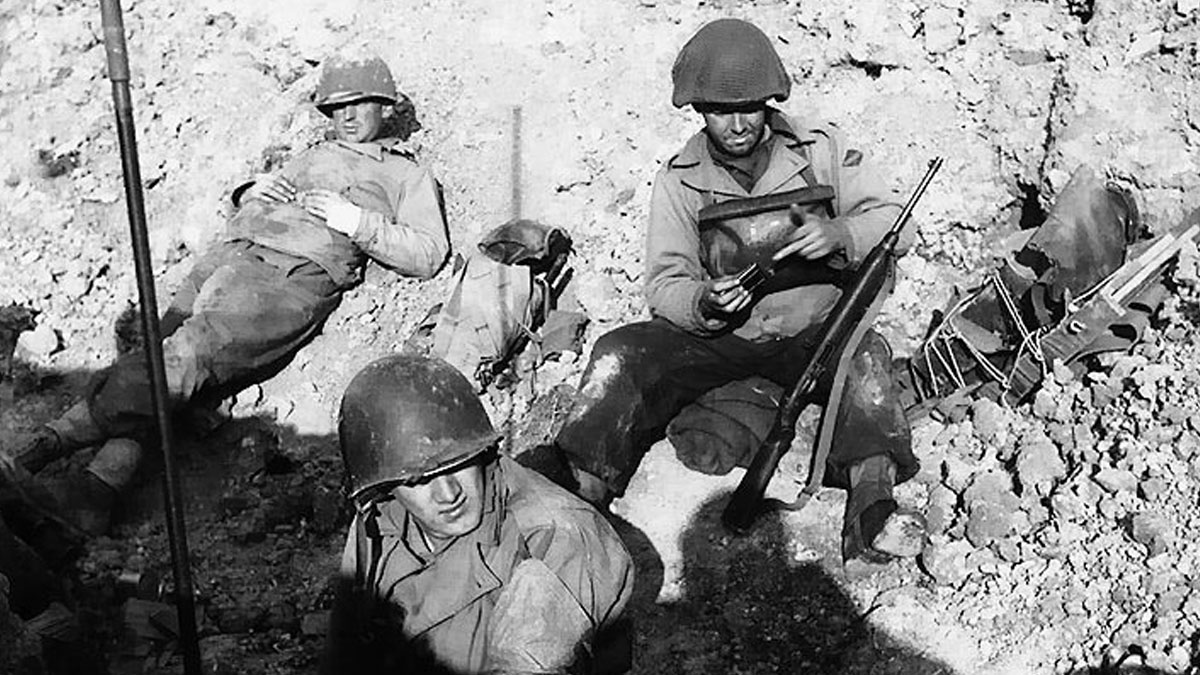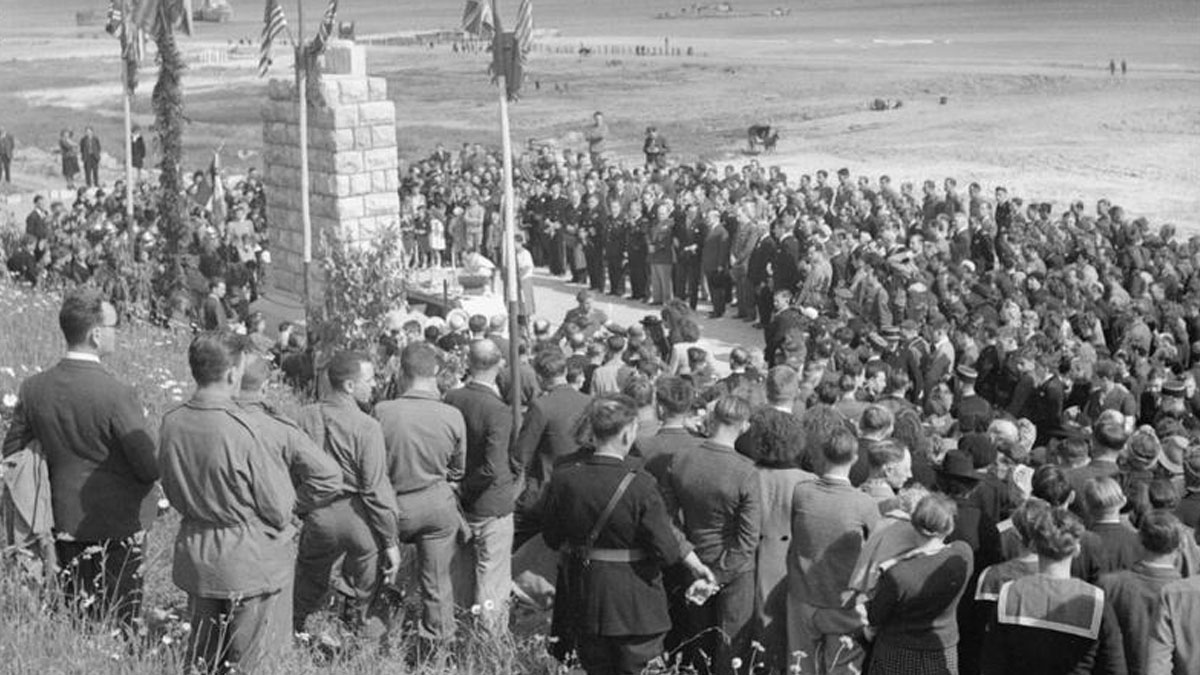Omaha Beach was the Allied code-name for one of the five sectors of the Normandy coastline. This part of German-occupied France lay on the English channel and is 8km long. It runs from east of Sainte-Honorine-des-Pertes through to west of Vierville-Sur-Mer. Taking Omaha was key to linking the British landings at Gold Beach to the American VII Corps landings at Utah Beach.
The beach was divided into ten sectors; Charlie, Dog Green, Dog White, Dog Red, Easy Green, Easy White, Easy Red, Fox Green, Fox White, and Fox Red.
The men who landed at Omaha
The landing on Omaha Beach on 6th June 1944 eventually resulted in an Allied win. Troops from the United States, United Kingdom, Canada and Free France took the beach.
The United States V Corps consisted of “The Big Red One” – 1st Infantry Division – who took the eastern half of Omaha. The untested 29th Infantry Division and nine companies of the US Army Rangers assaulted the western beach. They were assisted by the US Navy, US Coast Guard, Royal Navy, Royal Canadian Navy and the Free French Navy. Opposing them were the German LXXXIV Corps of the 352nd Infantry Division and the 439th Ost-Battalion.
Two kinds of people are staying on this beach, the dead and those who are going to die. Now, let’s get the hell out of here!
Colonel George Taylor – 16th Infantry Regiment – Omaha Beach – 6th June 1944
The initial assault consisted of tanks, infantry and combat engineer forces to secure the beach and allow ships to land. Although seen as a victory, over 2,000 men died and a further 1,000-1,200 were wounded.
What went wrong at Omaha?
The landings at Omaha were almost a total disaster. During the day of the 6th June, General Bradley considered aborting the mission and retreating. Only sheer grit from the men on the beaches meant they ended the day taking a small bridgehead.
Even before troops landed, things were going wrong. The air force had missed their targets, failing to destroy any defences or to crater the beaches. The infantry could have sheltered in the bombed out areas. The use of naval bombardment for only 30 minutes at daybreak was also not enough to rattle the German defences.
Strong currents and difficulties in navigating around Omaha meant that most troops missed their targets. Smaller landing craft in the hands of seasick men got lost in the waves. The heavy seas also swamped the landing tanks. Many were lost before they even made it to the shore and offered no help to the infantry.
The British made much more effective use of tanks including “Hobart’s Funnies”. These tanks improved the chances of making ground at Sword Beach and Gold Beach.
This section of the coast resembles the Bay of Salerno in Italy and therefore we should be on special guard against hostile landings!
Field Marshal Erwin Rommel
Germans offer strong resistance
German defences were much stronger than anticipated and US troops incurred heavy casualties. Rommel had created formidable defences, mining the waters and beach and moving in the battle-hardened 352nd Infantry Division. Allied intelligence had expected no more than 100 men of the weaker 716th Division.
Add to this, that many men disembarked on sandbars, heavily laden with 200 yards to go just to reach the sand. Those that made it ashore did it at walking pace. Engineer corps failed to clear many of the obstacles or exits from the beach. This caused problems for troops landing later in the day. Only five out of sixteen engineer teams arrived near their designated areas. Three teams even landed without the cover of infantry or armour. The engineers finally cleared six gaps at Dog White, Easy Green and four at Easy Red. They had lost more than 40% of their men.
At either end of Omaha, especially at Fox Green and Easy Red, losses were highest. In some cases, companies were reduced to half-strength by the time they had crawled only 300 yards. Other companies were able to use the chaos to their advantage and shelter by the cliffs and bluffs. Perhaps the biggest blow was that companies were leaderless, disorganised and all moral was gone.
From Northern Ireland to Bloody Omaha
It became clear the only way off the beach was to scale the cliffs. Out on the western side at Pointe-du-Hoc, this job fell to the US Rangers. This elite combat unit formed in Carrickfergus, Co. Antrim on 19th June 1942 and was instrumental in the American success at Omaha.
The US Rangers suffered some of the heaviest losses of any unit. They scaled the cliffs to find the German guns removed and themselves surrounded by infantry. Of 225 Rangers who landed at Omaha, 80 died on the beaches and only 90 were fit for battle by the end of the day.
American destroyers USS Arkansas, USS Nevada and USS Texas pounded the Normandy coastline taking out key positions. Only months earlier, the crews of these vessels were being addressed by Eisenhower in Belfast Lough.
Today at Omaha Beach
The shingle bank had disappeared days after D-Day and in the last 70 years the surrounding villages have grown. Despite some obvious differences, not much else has changed. The clifftop defences still stand in places and the remains of the Mulberry Harbour show at low-tide. Every now and again glasses, iron, shrapnel and munitions turn up in the golden sands.
In 2004, the French government erected “Les Braves” to honour the victorious Americans. The three sculptures stand in the centre of the beach close to the original monument from 1945. It consists of Wings of Hope, Rise of Freedom and the Wings of Fraternity. Designed by Anilore Banon, it’s a poignant reminder of the brotherhood of 1944 and the hope we have for nothing but peace on Omaha Beach of the future.
This post makes up part of our travel diary from the 70th-anniversary of D-Day in Normandy 2014.


